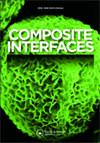Preparation of thermally stable organic-inorganic hybrid nanocomposites from chemically functionalized oxidized graphite by in situ catalytic oxidative decarboxylation
IF 2.4
4区 材料科学
Q3 MATERIALS SCIENCE, COMPOSITES
引用次数: 1
Abstract
ABSTRACT In this study, the preparation of thermally stable organic-inorganic hybrid nanocomposites from chemically functionalized oxidized graphite is carried out by in-situ catalytic oxidative decarboxylation of 3,5-dinitrobenzoic acid (reactant) in the presence of potassium persulfate (oxidant), silver nitrate (catalyst) and graphite (support) under thermal or microwave conditions. The effects of heat transfer and dosages of reactant, catalyst and oxidant on the crystalline structure and the morphology of nanocomposites are studied in detail. The prepared nanocomposites are characterized by EDS, elemental mapping, FE-SEM, FT-IR and XRD. The thermal stability of nanocomposites is examined by TGA and DSC. EDS shows that nanocomposites are composed of C, O, N, S, K and Ag elements. FT-IR exhibits that the graphitic layers in nanocomposites are mainly oxidized and functionalized with carboxyl, carbonyl, hydroxyl, epoxy, sulfate, nitrate and nitroaryl groups. Addition of nitroaryl groups to nanocomposites is also supported by an increase found in their C and N contents. XRD demonstrates the coexistence of both oxidized amorphous carbon and graphite in combination with different levels of organic and inorganic phases. The prepared nanocomposites show good thermal stability. The total area of the DSC curve in these nanocomposites compared to graphite is enhanced. Graphical abstract原位氧化脱羧法制备热稳定的有机-无机杂化纳米复合材料
本研究以氧化石墨为原料,在过硫酸钾(氧化剂)、硝酸银(催化剂)和石墨(载体)的存在下,通过原位催化3,5-二硝基苯甲酸(反应物)氧化脱羧,制备了热稳定的有机-无机杂化纳米复合材料。研究了热传递、反应物、催化剂和氧化剂用量对纳米复合材料晶体结构和形貌的影响。采用能谱分析(EDS)、元素映射、FE-SEM、FT-IR和XRD对所制备的纳米复合材料进行了表征。采用热重分析(TGA)和差热分析(DSC)对纳米复合材料的热稳定性进行了表征。能谱分析表明,纳米复合材料由C、O、N、S、K和Ag元素组成。傅里叶变换红外光谱表明,纳米复合材料中的石墨层主要被羧基、羰基、羟基、环氧基、硫酸盐、硝酸盐和硝基官能团氧化和官能团化。纳米复合材料中硝基基团的加入也支持其碳和氮含量的增加。XRD表明氧化后的无定形碳和石墨共存,并结合不同水平的有机相和无机相。所制备的纳米复合材料具有良好的热稳定性。与石墨相比,这些纳米复合材料的DSC曲线的总面积增加了。图形抽象
本文章由计算机程序翻译,如有差异,请以英文原文为准。
求助全文
约1分钟内获得全文
求助全文
来源期刊

Composite Interfaces
工程技术-材料科学:复合
CiteScore
5.00
自引率
3.80%
发文量
58
审稿时长
3 months
期刊介绍:
Composite Interfaces publishes interdisciplinary scientific and engineering research articles on composite interfaces/interphases and their related phenomena. Presenting new concepts for the fundamental understanding of composite interface study, the journal balances interest in chemistry, physical properties, mechanical properties, molecular structures, characterization techniques and theories.
Composite Interfaces covers a wide range of topics including - but not restricted to:
-surface treatment of reinforcing fibers and fillers-
effect of interface structure on mechanical properties, physical properties, curing and rheology-
coupling agents-
synthesis of matrices designed to promote adhesion-
molecular and atomic characterization of interfaces-
interfacial morphology-
dynamic mechanical study of interphases-
interfacial compatibilization-
adsorption-
tribology-
composites with organic, inorganic and metallic materials-
composites applied to aerospace, automotive, appliances, electronics, construction, marine, optical and biomedical fields
 求助内容:
求助内容: 应助结果提醒方式:
应助结果提醒方式:


